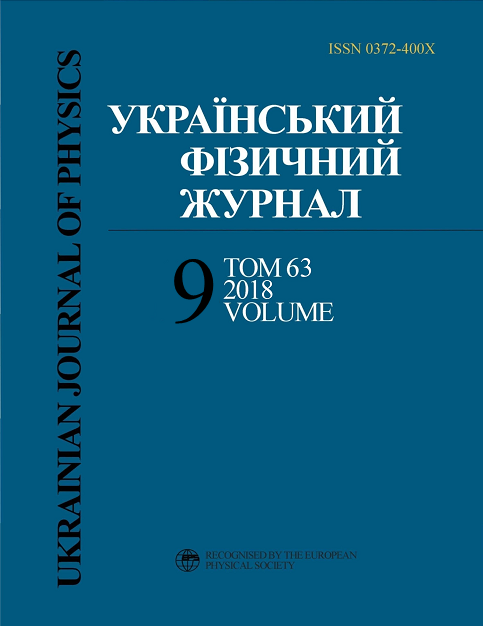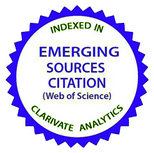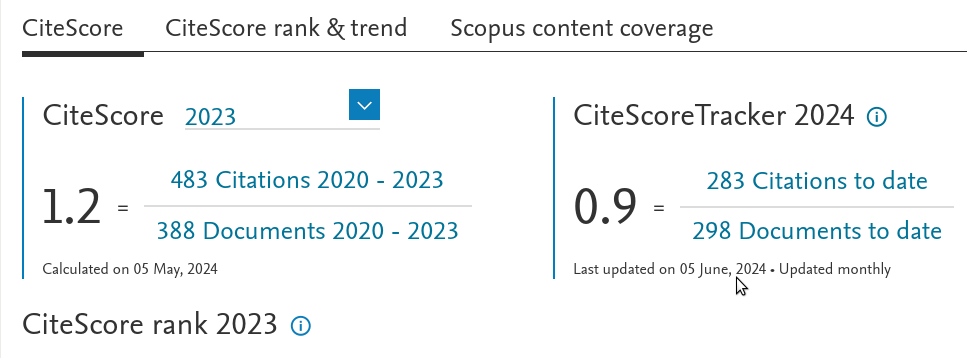Моделювання бактеріального хемотаксису в середовищі з репелентом
DOI:
https://doi.org/10.15407/ujpe63.9.802Ключові слова:
бактерiя, хемотаксис, репелент, атрактант, тамблiнгАнотація
Розглядається хемотаксис бактерiй в одновимiрнiй системi за умови наявностi там репеленту. Дослiджується процес просторового перерозподiлу бактерiй в системi. Для цього пропонується феноменологiчна математична модель. В моделi враховується дифузiя бактерiй та їх рух, пов’язаний
iз наявнiстю градiєнту репеленту. Режим пiдведення репеленту в систему реалiзується за рахунок граничних умов. Для такої системи розраховано функцiю чутливостi хемотаксису – числову характеристику, яка описує неоднорiднiсть розподiлу бактерiй. Отримано залежнiсть функцiї чутливостi хемотаксису вiд концентрацiї репеленту на границях системи. Знайдено зв’язок мiж характеристиками розподiлу репеленту та розподiлом бактерiй.
Посилання
<li>J.D. Murray. Mathematical Biology: I. An Introduction (Springer, 2007).
</li>
<li>T. Namba, M. Nishikawa, T. Shibata. The relation of signal transduction to the sensitivity and dynamic range of bacterial chemotaxis. Biophys. J. 103, 1390 (2012).
<a href="https://doi.org/10.1016/j.bpj.2012.08.034">https://doi.org/10.1016/j.bpj.2012.08.034</a>
</li>
<li>J. Adler. Chemotaxis in bacteria. Science 153, 708 (1966).
<a href="https://doi.org/10.1126/science.153.3737.708">https://doi.org/10.1126/science.153.3737.708</a>
</li>
<li>H.C. Berg, D.A. Brown. Chemotaxis in E. coli analysed by three-dimensional tracking. Nature 239, 500 (1972).
<a href="https://doi.org/10.1038/239500a0">https://doi.org/10.1038/239500a0</a>
</li>
<li>J. Adler. The sensing of chemicals by bacteria. Sci. Am. 234, No. 4, 40 (1976).
<a href="https://doi.org/10.1038/scientificamerican0476-40">https://doi.org/10.1038/scientificamerican0476-40</a>
</li>
<li>C. Zhang, R. He, R. Zhang, J. Yuan. Motor adaptive remodeling speeds up bacterial chemotactic adaptation. Biophys. J. 114, 1225 (2018).
<a href="https://doi.org/10.1016/j.bpj.2018.01.018">https://doi.org/10.1016/j.bpj.2018.01.018</a>
</li>
<li>A.J. Waite, N.W. Frankel, T. Emonet. Behavioral variability and phenotypic diversity in bacterial chemotaxis. Annu. Rev. Biophys. 47, 27 (2018).
<a href="https://doi.org/10.1146/annurev-biophys-062215-010954">https://doi.org/10.1146/annurev-biophys-062215-010954</a>
</li>
<li>J. Wong-Ng, A. Celani, M. Vergassola. Exploring the function of bacterial chemotaxis. Curr. Opin. Microbiol. 45, 16 (2018).
<a href="https://doi.org/10.1016/j.mib.2018.01.010">https://doi.org/10.1016/j.mib.2018.01.010</a>
</li>
<li>Z. Long, B. Quaife, H. Salman, Z.N. Oltvai. Cell-cell communication enhances bacterial chemotaxis toward external attractants. Sci. Rep. 7, 12855 (2017).
<a href="https://doi.org/10.1038/s41598-017-13183-9">https://doi.org/10.1038/s41598-017-13183-9</a>
</li>
<li> G. Si, T.Wu, Q. Ouyang, Y. Tu. Pathway-based mean-field model for Escherichia coli chemotaxis. Phys. Rev. Lett. 109, 048101 (2012).
<a href="https://doi.org/10.1103/PhysRevLett.109.048101">https://doi.org/10.1103/PhysRevLett.109.048101</a>
</li>
<li> Y.S. Dufour, X. Fu, L. Hernandez-Nunez, T. Emonet. Limits of feedback control in bacterial chemotaxis. PLoS Comput. Biol. 10, e1003694 (2014).
<a href="https://doi.org/10.1371/journal.pcbi.1003694">https://doi.org/10.1371/journal.pcbi.1003694</a>
</li>
<li> Y. Tu, T.S. Shimizu, H.C. Berg. Modeling the chemotactic response of Escherichia coli to time-varying stimuli. Proc. Natl. Acad. Sci. USA 105, 14855 (2008).
<a href="https://doi.org/10.1073/pnas.0807569105">https://doi.org/10.1073/pnas.0807569105</a>
</li>
<li> M.J. Schnitzer. Theory of continuum random walks and application to chemotaxis. Phys. Rev. E 48, 2553 (1993).
<a href="https://doi.org/10.1103/PhysRevE.48.2553">https://doi.org/10.1103/PhysRevE.48.2553</a>
</li>
<li> S. Asakura, H. Honda. Two-state model for bacterial chemo-receptor proteins. The role of multiple methylation. J. Mol. Biol. 176, 349 (1984).
<a href="https://doi.org/10.1016/0022-2836(84)90494-7">https://doi.org/10.1016/0022-2836(84)90494-7</a>
</li>
<li> V. Sourjik, H.C. Berg. Functional interactions between receptors in bacterial chemotaxis. Nature 428, 437 (2004).
<a href="https://doi.org/10.1038/nature02406">https://doi.org/10.1038/nature02406</a>
</li>
<li> D. Bray, M.D. Levin, C.J. Morton-Firth. Receptor clustering as a cellular mechanism to control sensitivity. Nature 393, 85 (1998).
<a href="https://doi.org/10.1038/30018">https://doi.org/10.1038/30018</a>
</li>
<li> B.A. Mello, Y. Tu. An allosteric model for heterogeneous receptor complexes: understanding bacterial chemotaxis responses to multiple stimuli. Proc. Natl. Acad. Sci. USA 102, 17354 (2005).
<a href="https://doi.org/10.1073/pnas.0506961102">https://doi.org/10.1073/pnas.0506961102</a>
</li>
<li> Y. Miyanaga, S. Matsuoka, T. Yanagida, M. Ueda. Stochastic signal inputs for chemotactic response in Dictyostelium cells revealed by single molecule imaging techniques. Biosystems 88, No. 3, 251 (2007).
<a href="https://doi.org/10.1016/j.biosystems.2006.07.011">https://doi.org/10.1016/j.biosystems.2006.07.011</a>
</li>
<li> P.G. de Gennes. Chemotaxis: the role of internal delays. Eur. Biophys. J. 33, 691 (2004).
<a href="https://doi.org/10.1007/s00249-004-0426-z">https://doi.org/10.1007/s00249-004-0426-z</a>
</li>
<li> E. Keller, L. Segel. Model for chemotaxis. J. Theor. Biol. 30, 225 (1971).
<a href="https://doi.org/10.1016/0022-5193(71)90050-6">https://doi.org/10.1016/0022-5193(71)90050-6</a>
</li>
<li> G.R. Ivanitskii, A.B. Medvinskii, M.A. Tsyganov. From disorder to ordering – on an example of microorganism motion. Usp. Fiz. Nauk 161, 13 (1991) (in Russian).
<a href="https://doi.org/10.3367/UFNr.0161.199104b.0013">https://doi.org/10.3367/UFNr.0161.199104b.0013</a>
</li>
<li> O.M. Vasilev, D.E. Sakovich, Modeling of bacterial chemotaxis in a one-dimensional system. Zh. Fiz. Dosl. 19, 1801 (2015) (in Ukrainian).
</li>
<li> D.V. Bogdanov, O.M. Vasilev. Chemotaxis sensitivity function for a two-dimensional system with a radial symmetry. Zh. Fiz. Dosl. 21, 3801 (2017) (in Ukrainian).
</li>
<li> A.N. Vasilev. Analytical approach for calculating the chemotaxis sensitivity function. Ukr. J. Phys. 63, 255 (2018).
<a href="https://doi.org/10.15407/ujpe63.3.255">https://doi.org/10.15407/ujpe63.3.255</a>
</li>
</ol>
##submission.downloads##
Опубліковано
Як цитувати
Номер
Розділ
Ліцензія
Ліцензійний Договір
на використання Твору
м. Київ, Україна
Відповідальний автор та співавтори (надалі іменовані як Автор(и)) статті, яку він (вони) подають до Українського фізичного журналу, (надалі іменована як Твір) з одного боку та Інститут теоретичної фізики імені М.М. Боголюбова НАН України в особі директора (надалі – Видавець) з іншого боку уклали даний Договір про таке:
1. Предмет договору.
Автор(и) надає(ють) Видавцю безоплатно невиключні права на використання Твору (наукового, технічного або іншого характеру) на умовах, визначених цим Договором.
2. Способи використання Твору.
2.1. Автор(и) надає(ють) Видавцю право на використання Твору таким чином:
2.1.1. Використовувати Твір шляхом його видання в Українському фізичному журналі (далі – Видання) мовою оригіналу та в перекладі на англійську (погоджений Автором(ами) і Видавцем примірник Твору, прийнятого до друку, є невід’ємною частиною Ліцензійного договору).
2.1.2. Переробляти, адаптувати або іншим чином змінювати Твір за погодженням з Автором(ами).
2.1.3. Перекладати Твір у випадку, коли Твір викладений іншою мовою, ніж мова, якою передбачена публікація у Виданні.
2.2. Якщо Автор(и) виявить(лять) бажання використовувати Твір в інший спосіб, як то публікувати перекладену версію Твору (окрім випадку, зазначеного в п. 2.1.3 цього Договору); розміщувати повністю або частково в мережі Інтернет; публікувати Твір в інших, у тому числі іноземних, виданнях; включати Твір як складову частину інших збірників, антологій, енциклопедій тощо, то Автор(и) мають отримати на це письмовий дозвіл від Видавця.
3. Територія використання.
Автор(и) надає(ють) Видавцю право на використання Твору способами, зазначеними у п.п. 2.1.1–2.1.3 цього Договору, на території України, а також право на розповсюдження Твору як невід’ємної складової частини Видання на території України та інших країн шляхом передплати, продажу та безоплатної передачі третій стороні.
4. Строк, на який надаються права.
4.1. Договір є чинним з дати підписання та діє протягом усього часу функціонування Видання.
5. Застереження.
5.1. Автор(и) заявляє(ють), що:
– він/вона є автором (співавтором) Твору;
– авторські права на даний Твір не передані іншій стороні;
– даний Твір не був раніше опублікований і не буде опублікований у будь-якому іншому виданні до публікації його Видавцем (див. також п. 2.2);
– Автор(и) не порушив(ли) права інтелектуальної власності інших осіб. Якщо у Творі наведені матеріали інших осіб за виключенням випадків цитування в обсязі, виправданому науковим, інформаційним або критичним характером Твору, використання таких матеріалів здійснене Автором(ами) з дотриманням норм міжнародного законодавства і законодавства України.
6. Реквізити і підписи сторін.
Видавець: Інститут теоретичної фізики імені М.М. Боголюбова НАН України.
Адреса: м. Київ, вул. Метрологічна 14-б.
Автор: Електронний підпис від імені та за погодження всіх співавторів.













